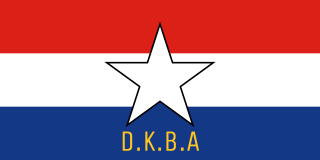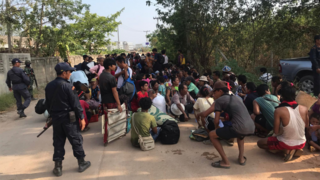
The Karen National Union is a political organisation with an armed wing, the Karen National Liberation Army (KNLA), that claims to represent the Karen people of Myanmar. It operates in mountainous eastern Myanmar and has underground networks in other areas of Myanmar where Karen people live as a minority group.
Manerplaw was a village in Kayin State, Myanmar (Burma), on the Moei River. It was the proposed capital of an independent state governed by the Karen people, known locally as Kawthoolei. Manerplaw was established in 1975 and had a population of around 3,000 in 1992 until its evacuation following military offensives by the government.
Bo Mya was a Karen leader born in Papun District, which is in present-day Karen State, Myanmar. He was a long-standing chairman of the Karen National Union (KNU), a political organisation of the Karen people, from 1976 to 2000. He stepped down to become vice-chairman in 2004, and retired in 2004 from all public offices, due to poor health.

The Karen National Liberation Army is the military branch of the Karen National Union (KNU), which campaigns for the self-determination of the Karen people of Myanmar. The KNLA has been fighting the Burmese government since 1960s as part of the Karen conflict, which has been ongoing since 1949.

Myanmar has been embroiled in armed conflict since 1948, when the country, then known as Burma, gained independence from the United Kingdom. The conflict has largely been ethnic-based, with ethnic armed organisations fighting Myanmar's armed forces, the Tatmadaw, for self-determination. Despite numerous ceasefires and the creation of autonomous self-administered zones in 2008, armed groups continue to call for independence, increased autonomy, or the federalisation of Myanmar. It is the world's longest ongoing civil war, spanning almost eight decades.

The Democratic Karen Buddhist Army was an insurgent group of Buddhist soldiers and officers in Myanmar that split from the predominantly Christian-led Karen National Liberation Army (KNLA), one of the largest rebel factions in Myanmar. Shortly after splitting from the KNLA in December 1994, the DKBA signed a ceasefire agreement with the government of Myanmar in exchange for military and financial assistance; provided that it supported government offensives against the KNU and its allies.
The 2010–2012 Myanmar border clashes were a series of skirmishes between the Tatmadaw on one side, and the DKBA-5 and the Karen National Liberation Army (KNLA) on the other. The clashes erupted along the border with Thailand shortly after Myanmar's general election on 7 November 2010. An estimated 10,000 refugees have fled into nearby neighbouring Thailand to escape the violent conflict. There was concern that due to discontent with the elections, and speculations of electoral fraud, that the conflict could escalate into a civil war.

Mae La, alternatively spelled Maela, or Beh klaw, is a refugee camp in Thailand. It was established in 1984 in Tha Song Yang District, Tak Province in the Dawna Range area and houses 50,000 Karen refugees; the number continues to rise as of June 2019. Mae La is the largest refugee camp for Karen refugees in Thailand. Over 90% are the persecuted ethnic Karen. The camps are overseen and run by the Thailand Burma Border Consortium (TBBC), a union of 11 international non-governmental organizations that provide food, shelter and non food items to the Burmese refugees and displaced people.

The Karen conflict is an armed conflict in Kayin State, Myanmar. It is part of the wider internal conflict in Myanmar between the military government and various minority groups. Karen nationalists have been fighting for an independent state, known as Kawthoolei, since 1949. The Karen National Union (KNU) and its Karen National Liberation Army (KNLA) are the most prominent Karen rebel groups. Hundreds of thousands of civilians have been displaced by the conflict, many of whom fled to neighbouring Thailand and survive in refugee camps.

The Mon National Liberation Army is a Mon insurgent group in Myanmar (Burma). It is the armed wing of the New Mon State Party (NMSP), and has been fighting government forces since 1949, though under different names. The NMSP signed the Nationwide Ceasefire Agreement (NCA) on 15 October 2015 with several other insurgent groups and the government of Myanmar.

The Karen National Defence Organisation is the older of two main military branches of the Karen National Union (KNU), the other being the Karen National Liberation Army (KNLA). The KNDO fought against the government of Myanmar from 1947 until 1949 as the armed wing of the KNU. It was succeeded by the KNLA when KNDO militias were combined with KNLA forces in 1970.
The Battle of Kawmoora (ကော်မူးရာတိုက်ပွဲ), also known as the Battle of Wan Kha Thit (ဝမ်ခသစ်တိုက်ပွဲ), was a protracted battle between the Tatmadaw and the Karen National Liberation Army (KNLA). Before 1994, the Tatmadaw was unable to capture the KNLA stronghold of Kawmoora due to the stronghold's robust fortifications and narrow access from Tatmadaw-held territory. The Tatmadaw instead fired artillery at enemy positions from Thai territory, with the permission of the Thai government. However, the Fall of Manerplaw on 27 January 1995 allowed the Tatmadaw to advance southward and capture Kawmoora on 21 February.
Thuzana, also known as the Myainggyi-ngu Sayadaw, was a Karen Theravada Buddhist monk based in Myaing Gyi Ngu, Kayin State, Myanmar. He was the leader of the Democratic Karen Buddhist Army (DKBA), an ethnic insurgent group, until its dissolution in 2010.
The Karen–Mon conflict is a series of armed clashes between the ethnic rebel armies of the Karen and Mon peoples. The Karen National Liberation Army and the Mon National Liberation Army have clashed sporadically since 1988, mostly around the Myanmar–Thailand border at Three Pagodas Pass.
Yar Pyae is a Myanmar Army officer and the Minister for the Union Government Office as of 11 May 2021. He was appointed as the National Security Advisor on 22 May 2021.

The Myanmar Civil War, also known as the Burmese Civil War, Burmese Spring Revolution or People's Defensive War, is an ongoing civil war since 2021. It began following Myanmar's long-running insurgencies, which escalated significantly in response to the 2021 coup d'état and the subsequent violent crackdown on anti-coup protests. The exiled National Unity Government and major ethnic armed organisations repudiated the 2008 Constitution and called instead for a democratic federal state. Besides engaging this alliance, the ruling government of the State Administration Council (SAC), also contends with other anti-SAC forces in areas under its control. Hannah Beech of The New York Times observed the insurgents are apportioned into hundreds of armed groups scattered across the country.
Colonel Saw Chit Thu is a Karen soldier and businessperson, sometimes identified as a warlord, who has held a leading position in armed groups in Karen State, Myanmar, including the Democratic Karen Buddhist Army (DKBA), the Border Guard Forces (BGF) and the Karen National Army (KNA). He is considered a powerful figure in the border area, and has been sanctioned by the United Kingdom for links to projects which use trafficked and forced labour in online scam farms.

The siege of Myawaddy was a significant military engagement that occurred in early 2024 during the ongoing conflict in Myanmar. The siege took place in the town of Myawaddy, located on the eastern border with Thailand.

The Karen National Army, formerly the Karen Border Guard Force, is a primarily Karen Buddhist ethnic army active in Kayin State, Myanmar, which split off from the Myanmar Army in January 2024. The KNA was formed as the Democratic Karen Buddhist Army (DKBA) in December 1994 after the insurgent group split off of the Karen National Liberation Army. Shortly after, the DKBA signed a ceasefire agreement with the Myanmar Army, officially joining the army as the Karen Border Guard Force alongside the Karen Peace Force in 2009. In January 2024, after intensified rebel operations throughout Myanmar, the Karen BGF began distancing itself from the ruling military junta, eventually splitting off from the Army and rebranding themselves the "Karen National Army" by April.
The Kawthoolei Armed Forces is an ethnic Karen rebel alliance.










